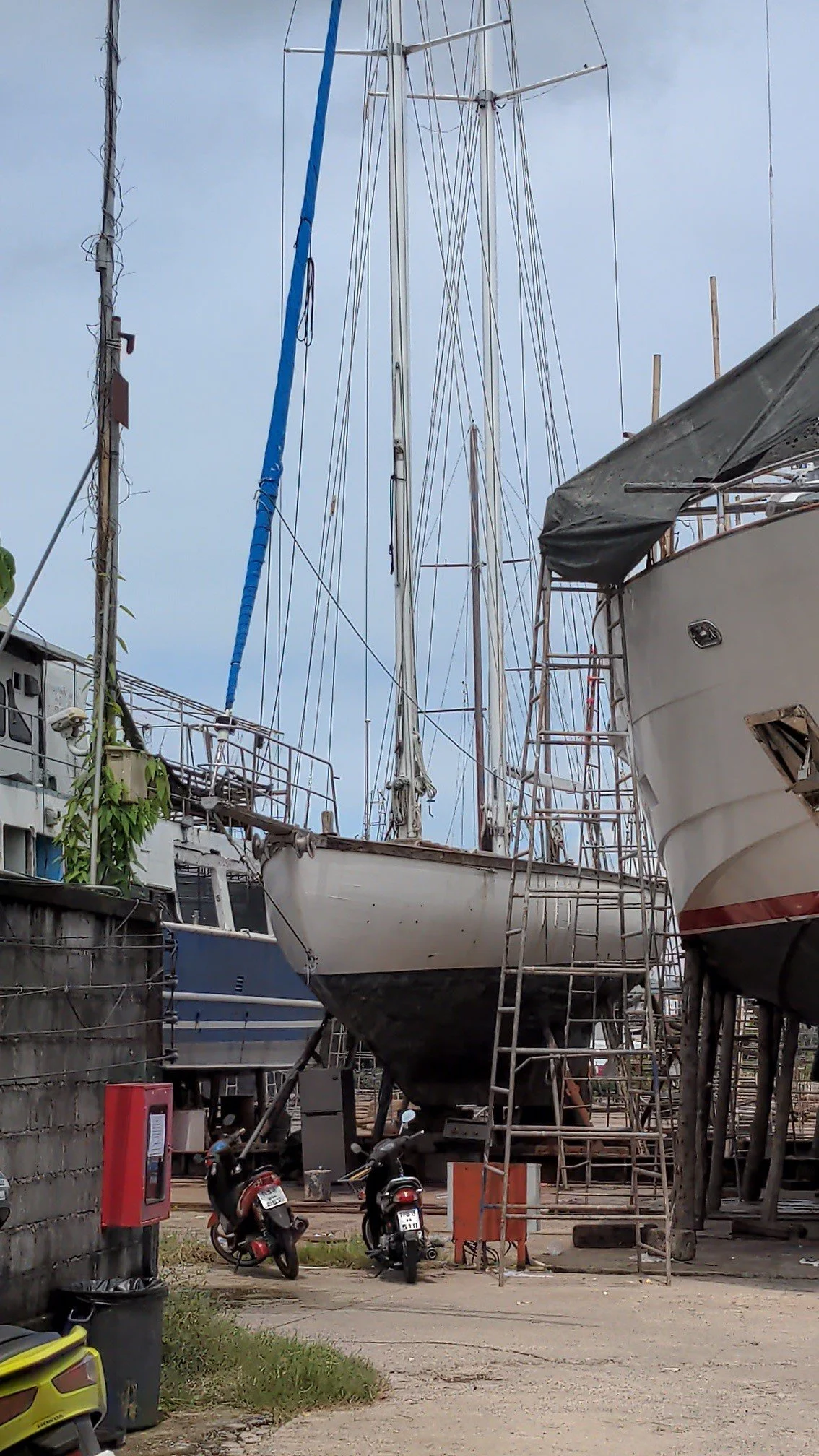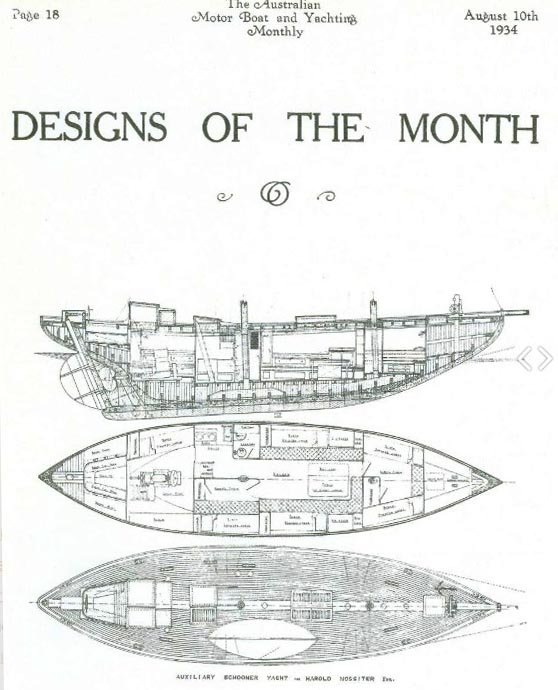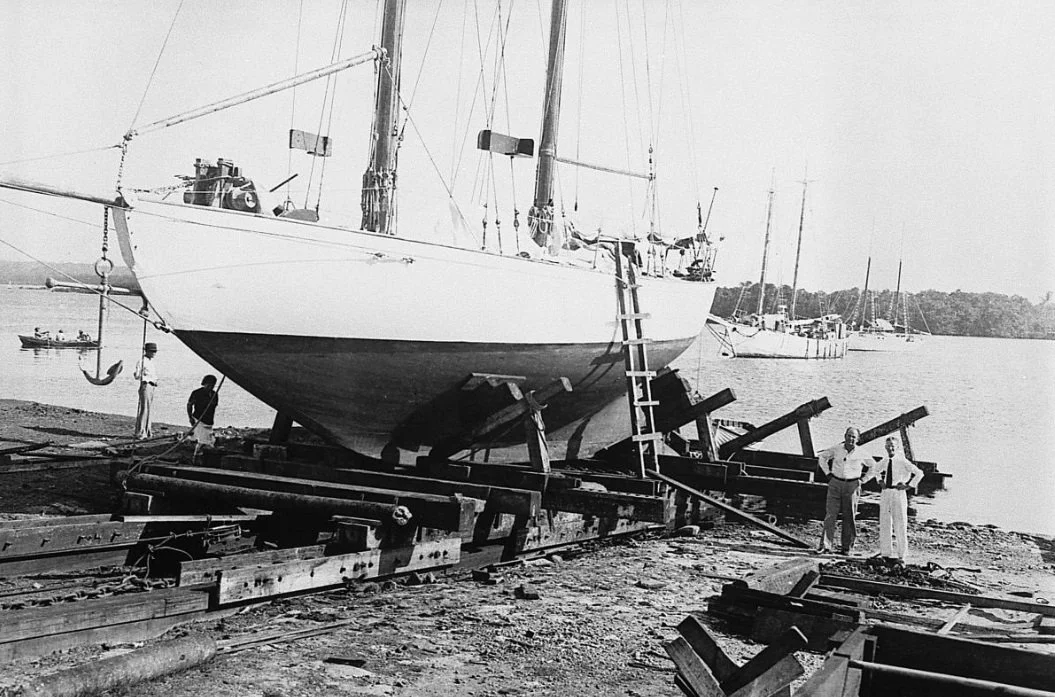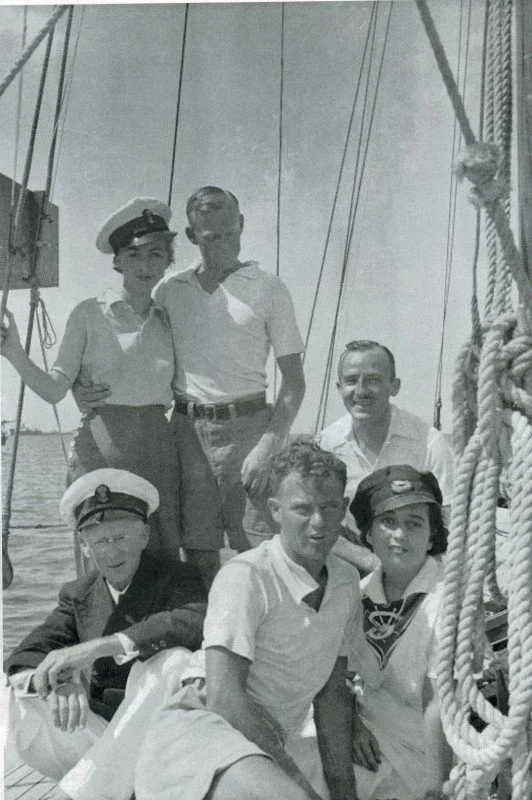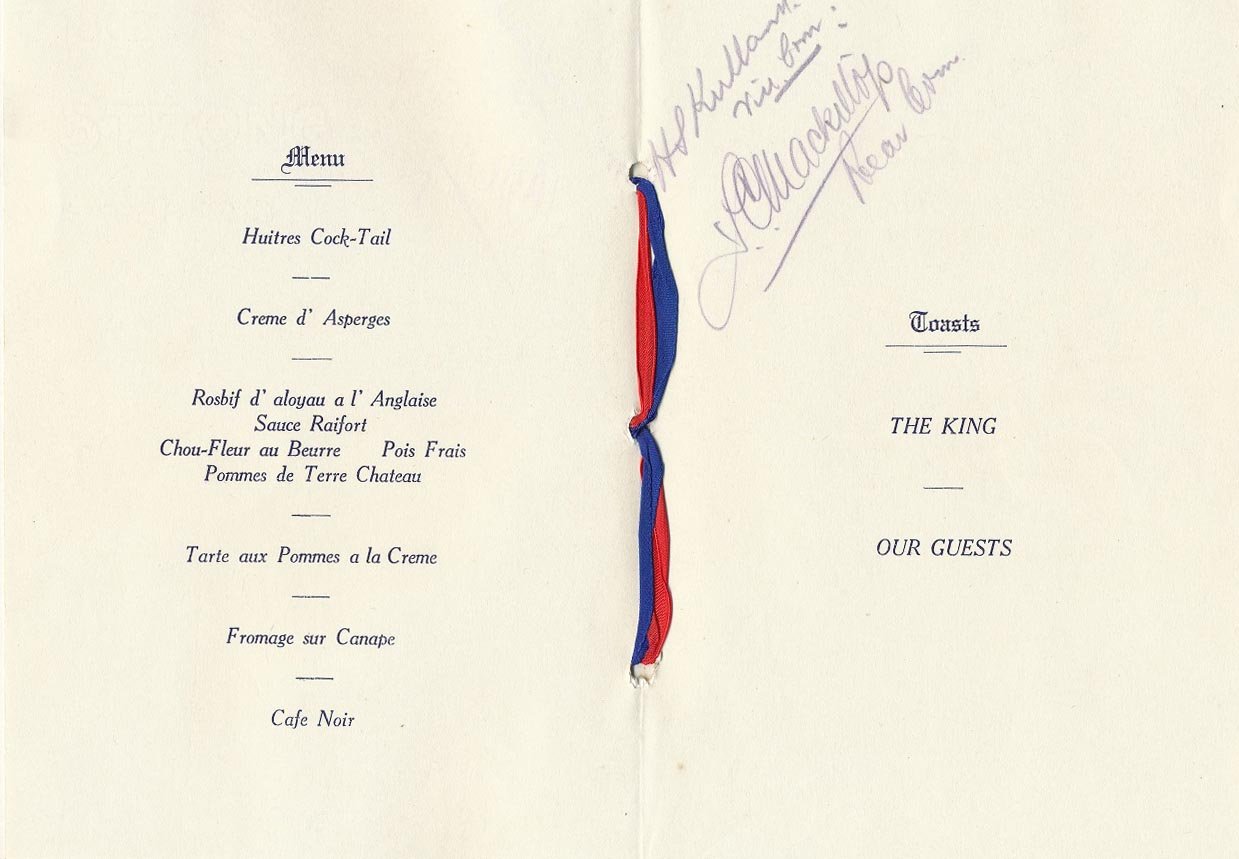Saving SIRIUS-Australia’s first Circumnavigator
Earlier this week Malcolm Lambe, our regular correspondent from Pittwater, alerted SWS to this story, which seems to be heading for a sad ending unless an angel appears from behind a cloud in Thailand.
Here’s the gist of it…..
Simon Morris, the previous owner of the historic Australian yacht SIRIUS, is looking for help.
This is the yacht the Nossiter family built and circumnavigated the globe in, the first Australians to do so and also the first Australian yacht to do so. SIRIUS (1935), had been 'sold' to a gentleman who then ran into difficulties with unscrupulous repairers, losing his home and others assets, prior to Covid lockdowns negating any chance for a reversal of fortunes through the Thailand charter business for her.
She currently sits rotting away with a foot of rainwater in the bilges.
According to the contract that the owner signed, the shipyard can repossess the yacht due to unpaid bills over three months or no contact with him for six months.
The owner has since relinquished control and responsibility for SIRIUS back to Simon.
As he explains;
''I am not in a position to to carry out the necessary renovations myself, either physically or financially, so unless someone steps forward in the next couple of weeks, I’ll have to start scrapping her.
I’ll inform the Australian Register of Historic Vessels and the Australian Association for Maritime History.
There is little time left to save SIRIUS but if anyone is prepared to I’ll transfer the majority 33 shares to them on condition that they pay the shipyard arrears ($5,780) and commit to the costs of restoration.''
If anyone is interested they can email Simon at: sirius1935@gmail.com
''This picture was taken a week ago. The mainsail and genoa are still in place with the masts and all the rigging but the interior has been completely stripped out.''
(many thanks to Alison Guesdon’s Pittwater Online News for the lead)
The background-Australia’s first Circumnavigator
In 1932 the legendary Australian yachtsman, Harold Nossiter, won the Lipton Cup, one of Australia's most coveted yachting trophies. Nossiter was planning retirement from his Sydney-based importing business in order to circumnavigate the world by yacht. His own yacht UTIEKAH II was a good sea boat but had little forefoot and would not heave-to, so Nossiter considered her unsuitable for the purpose. He wanted a boat custom-built to a more advanced design and took his ideas to J D Thistlewaite, a naval architect in Greenwich (NSW), who made drawings and completed the design in 1933.
The vessel was to be a canoe-stemmed staysail schooner of some 35 tons displacement, with accommodation for six. The overall length was to be 62 feet, its length on deck 53 ft 6 ins, beam 13 ft 6 ins, draft 7 fi 6 ins , and she was to carry 1,600 sq ft of sail. The yacht's lines showed a full-bodied hull of generous displacement. Her all-timber construction comprised New Zealand kauri above the waterline and Western Australian jarrah planking below. The keel, timbers and deck beams were of spotted gum and the stem ti-tree. The design was handed over to J Hayes and Sons, boat builders of Careening Cove (NSW), and the keel was laid in February 1934.
The yacht, named SIRIUS after the brightest of all navigation stars, was launched on 6 February 1935, watched by a crowd of 300. The masts and rigging were erected when she was in the water and she was fitted with an 18-horsepower Jersey City Standard petrol engine.
Harold Nossiter took delivery in April with time only for two short coastal cruises by way of sea trials, before 14 July 1935 when the circumnavigation was to commence. With Nossiter, his two sons Harold Jnr and Dick, and a friend, Clive Russell, aboard, SIRIUS sailed out of Sydney Harbour on what was to be a 28,000-mile voyage, lasting 20 months.
Their route initially took them north to Rabaul in New Guinea then to Buton and Komodo in the Dutch East Indies.
Clive Russell, the least experienced of the crew, became confused at the helm one night early in the voyage and almost put SIRIUS on a reef. Harold Nossiter awoke to the sound of the breaking waves and managed to start the engine in time to avoid disaster by 20 feet. Nossiter reported that after this incident, the responsibility of steering alone at night affected Russell's nerves. He would wake at night in his cabin and flash his torch about looking for the compass, thinking he was still steering. At one stage Nossiter considered abandoning the world voyage and circumnavigating Australia instead, but the eldest crew member, Harold Jnr, was determined to continue and he urged on the rest of the crew.
They pressed on to Bali and Batavia (Jakarta) on the island of Java, then Singapore and Penang, where SIRIUS was hauled out to have her hull cleaned and anti-fouled. They came off the slip on 10 November and set sail for the Langkawi Islands on the Straits of Malacca, mooring at Kuah on l6 November.
Tunku Abdul Rahman (a son of the Sultan of Kedah and a Thai princess, who was later to become the first Prime Minister of Malaysia) was in charge of the district. He and his English wife entertained the crew at home and made their stay very pleasant. The Tunku gave Harold Jnr a Malay kris, which became a treasured heirloom for the rest of his long life.
At Colombo in Ceylon (now Sri Lanka) Clive Russell left the vessel, suffering from nervous exhaustion. On the next leg of the journey to Aden, with the wind almost dead aft, in a confused and nasty sea, the crew were having difficulty steering. Dick Nossiter recalls with a chuckle: 'We told father it was impossible to steer that course but he insisted it could be done and took control. While steering at night the boom swung over and the yacht gybed, breaking the boom. After that, whenever he told us we were doing something wrong we could always remind him that he broke the boom!'
Dick was the navigator and with a sextant, chronometer, nautical almanac and tables he guided the vessel accurately, making good landfalls throughout the voyage. They passed through the Suez Canal and across the Mediterranean, stopping at Crete and Cephalonia before passing through the Corinth Canal. The rest of the voyage across the Mediterranean was very hard, with headwinds and storms all the way. Off Italy, in a hailstorm, the cockpit and gunwales were full of ice. In Malta, where the crew couldn't get the yacht slipped, midshipmen from HMS Australia offered to dive and clean the bottom.
SIRIUS left the island with an additional crew member - a young cat they named Oliver Twist, because it was always meowing for more food. The journey to Gibraltar in April 1936 was difficult, with gale-force winds on the nose. The cat had to be kept below most of the time, growing louder and more and more annoying until one day he disappeared. It was assumed he had been washed overboard. Long after, Harold Jnr confessed to the dark deed.
The yacht entered the Atlantic on 12 May, sailing past Cape Finisterre and across the Bay of Biscay to anchor in Plymouth on 2 June 1936. Harold wrote in the logbook: 'How apt are the words "for England home and beauty." SIRIUS had come through the rough and tumble of the voyage very well indeed, and showed no signs whatever of strain. Nor did the remaining crew, who were not affected by seasickness, never missed a meal, and could always stay below in the worst weather without discomfort.
The party left England on 17 September 1936 to return to Australia via Madeira and Trinidad. On 1 December, as they approached Panama, they saw hundreds of floating trees and stumps, narrowly escaping collisions in the dark. Many of the larger logs might have stove them in, but since there was neither a heavy sea nor a hard wind, they received just a few glancing blows. In Colon, SIRIUS was hauled out for a final overhaul before proceeding through the canal for the long run across the Pacific Ocean.
The crew in Trinidad
SIRIUS left Cristobal under power with a pilot and passed through the first lock. As the lines were cast adrift, the pilot at the wheel ordered full speed ahead. The water swirling in the lock swung the yacht around and with the engine at full power they rammed into the wall. The 1 &¾ inch wire-rope bobstay snapped, and Sirius hung on the wall of the dock by her bowsprit, which was made of Australian spotted gum. The rushing waters then picked up SIRIUS and deposited her back in the lock, without breaking the gammon iron (the fitting that holds the bowsprit to the stem). The port captain, Captain Rodges, kindly offered to straighten some rigging screws and replace the bobstay, so the yacht was soon ready to sail.
SIRIUS entered the Pacific Ocean and reached Cocos Island (300 miles west of Panama) on New Year's Day 1937, anchoring in Chatham Bay. Five days later the Sirius crew hoisted sail for their Pacific passage and made for Santa Cruz (Indefatigable Island), one of the Galapagos Islands, four hundred miles away. The wind and current were against them all the way, so they had a long beat to windward. Then came the longest leg of the journey, the 3,000 miles to the Marquesas Islands. Helped now by the south-east tradewinds, they reached Fatu Hiva (Magdaline Island), the most southerly island of the Marquesas Archipelago, after 19 days at sea. When they weighed anchor there on 21 February they carried the mail for nearby Nuku Hiva (Marchand Island).
The route through French Polynesia took them to the atoll of Takaroa in the Tuamotu Archipelago where they picked up the next load of mail and headed on to Tahiti and Bora Bora in the Society Islands. Pressing on through the tropical Pacific they sailed via Raratonga in the Cook Islands and Nukualofa in the Tongan Islands.
The last part of the journey was the toughest. As they sailed down the east coast of Australia, they encountered a severe storm with Force 12 winds from the south. They had to lay ahull: enormous waves broke ahead and aft of them, but none came crashing onto the decks. After three days the current had taken them ten miles further south, towards Sydney.
On 20 May 1937 Sirius dropped anchor in Watsons Bay, Sydney. Harold Nossiter and his sons Dick and Harold became the first Australians to circumnavigate the world in a yacht. They had sailed SIRIUS 28,145 nautical miles, making her the first Australian-built yacht to achieve this remarkable feat.
Thanks to the ANMM publication “Signals” for background on the article.
Some More Recent history
After a sucessfull few years of harbour racing, during WWII, when SIRIUS was pressed into service as a training ship. After the war she was sold and took part in the second Sydney-Hobart race in 1946, and again the following year, when she finished l5th out of 28. In the 1950s, SIRIUS was sold again and used to carry copra in the Solomon Islands. In I965 she changed hands once more and supported helicopter operations in New Guinea. A tsunami struck while she was there and SIRIUS was beached high and dry. There was no heavy-lifting equipment to put her back in the water, but fortunately another tsunami a few hours later washed her back to sea.
She returned to Australia in 1974 where she was left in Cairns, and in 1983 she sank in a hurricane.
Over the next seven years SIRIUS was restored, then sold and taken to Indonesia. After a few years of charter work in Bali and Sumatra, she was nearly wrecked on a reef, then sailed to southern Thailand and repaired. In 2001 she was bought by her eighth owner Simon Morris, mentioned at the start of this article.
SIRIUS sailing Surf Charters in Indonesia in the 1990’s


